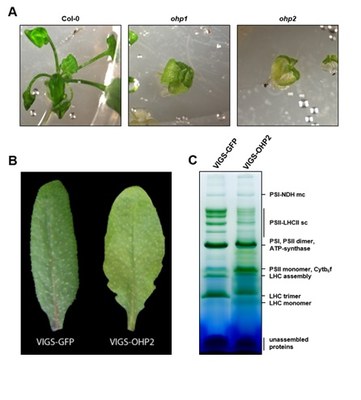One-Helix Proteins (OHPs) in Arabidopsis
Daniel Hey
In contrast to the first functional analyses of the Lil3-proteins in plants, almost nothing is known so far about the biological function of the OHPs of higher plants. Most work for this subclass of LHC proteins was performed with the OHP homologs of cyanobacteria, the high-light-inducible proteins (Hlips).
The Arabidopsis ohp1 and ohp2 knock-out mutants develop to small pale and extremely growth-retarded seedlings (Figure A). By using the VIGS-system (virus-induced gene silencing) we are able to selectively silence the AtOHP-gene expression in young Arabidopsis seedlings, which allow comparative biochemical studies of the chloroplast protein composition in plastid membranes. In our current working model OHP1 is related to the early steps of chlorophyll biosynthesis, whereas OHP2 to the late steps and to the chlorophyll assembly into proteins of photosystem II subunits (Figure B and C).
In further work we intend to explore the effects of overproduction of the OHPs in planta, as well as to perform a more detailed characterization of the biochemical properties of the OHP proteins in vitro.

A: Phenotype of wild-type seedlings and mutants carrying a T-DNA-insertion in the OHP1- or OHP2-gene, respectively. Plants were grown on MS-plates with 2% sucrose under continuous low light. B: Pale-green phenotype of Arabidopsis leaves infiltrated with Agrobacteria carrying a pTRV2-OHP2 construct. C: Blue-native PAGE of thylakoid membranes isolated from VIGS-plants, reflecting the extensive changes occurring in the absence of the OHP2 protein.